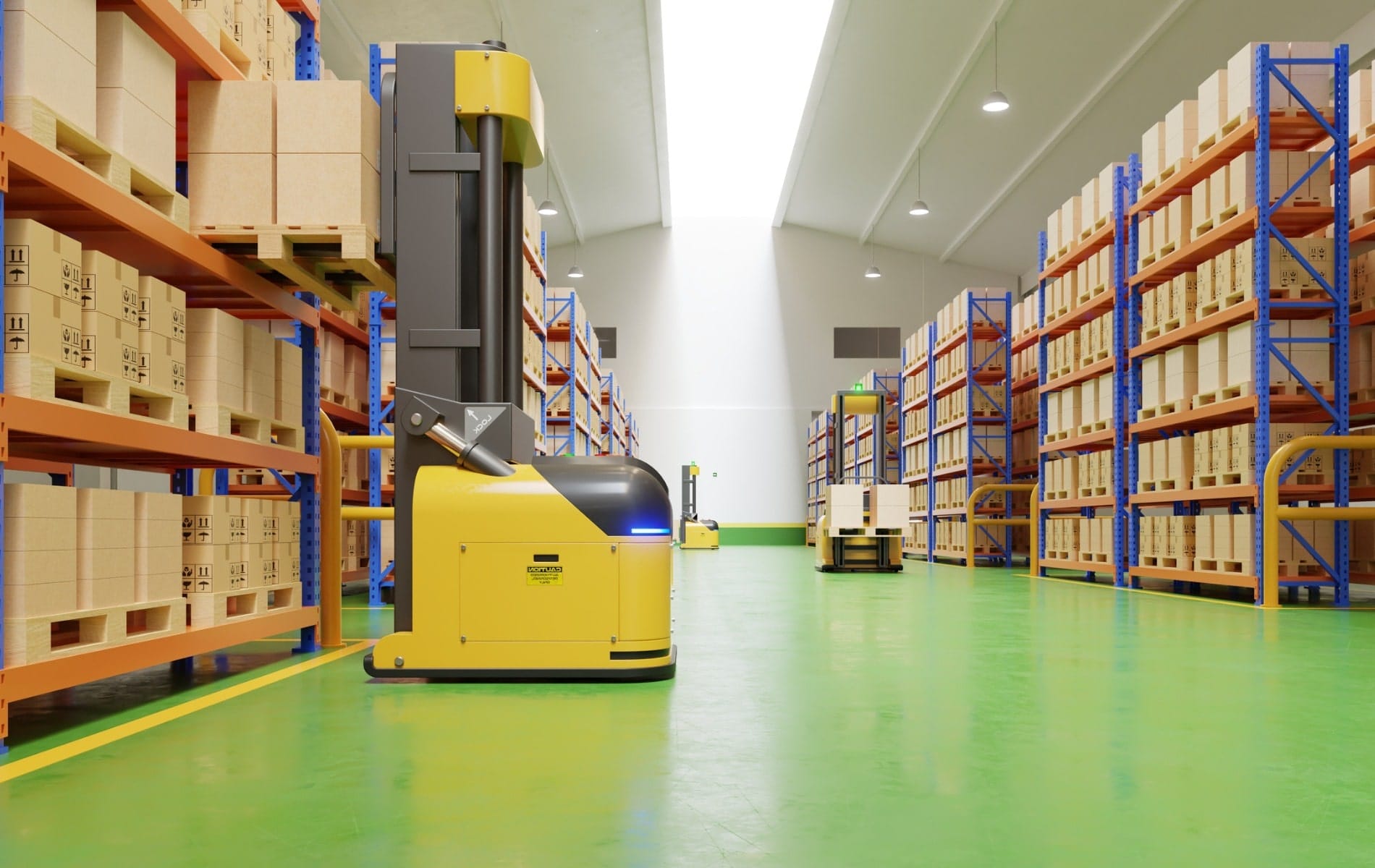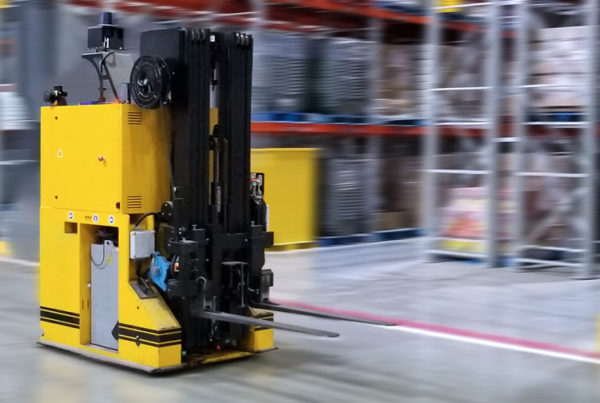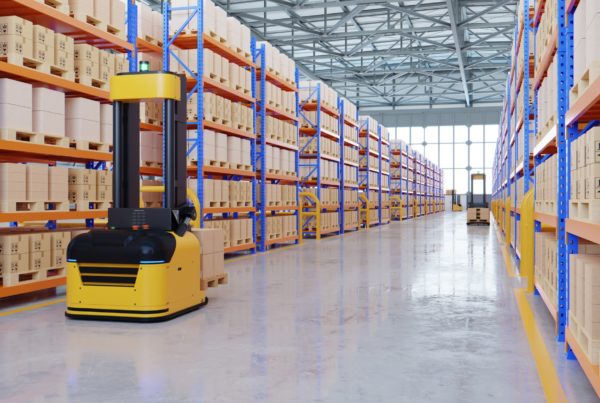Automated Guided Vehicles (AGVs) make the global supply chain possible, moving material from raw goods, through the production process, and out to the consumer. They are used in a wide variety of industries, from manufacturing and warehousing to medical care and even theme parks.
Like most automation, AGVs offer increased accuracies and throughputs compared to a traditional workforce, while reducing labor and other operational costs. Their benefits over other automation – such as conveyors, automated mobile robots, and automated storage and retrieval systems – include more seamless integration into facilities that are already in operation, and a wide variety of models and applications.
AGVs are a versatile, affordable supplement to – or even upgrade over – a traditional labor force. But not all AGVs were created equal, and there are applications where a facility would be better served by a different type of automation.
Which automated system is best for your facilities depends on the exact application and needs of the system.
Concerns and Choices
Budget, timeline, and current operations are always primary concerns in the design and implementation of any automated system. Because AGVs are among the most versatile systems on the market, they can also be among the most affordable. They can be purchased as individual units or entire fleets, depending on the need and purchasing power of the operation. And AGV navigational systems require few, usually minor, changes to a facility’s infrastructure, enabling them to be implemented with minimal downtime.
Space is another consideration. Limited or cluttered floor space may indicate that an overhead system – or perhaps a different solution entirely – is best. Tight corners or narrow aisles indicate the need for smaller machines or differential steering.
The tasks the AGVs will perform are also key to implementing the right system. AGVs can be used to transition material to and from conveyors, to interact with people and aid ergonomics, kitting and staging material for production and shipping, and much more.
Maximizing the ROI on the investment in AGVs requires fitting the right system to the facility’s processes.
Navigation systems
AGVs first came to market in the 1950’s. As technology and needs have changed, they’ve been adapted to use a wide variety of navigational technologies.
Fixed-path systems
Fixed-path systems are simple and reliable. The AGV follows a route that is marked by reflective or magnetic tape, colored paint, or a radio signal emitted by a wire embedded in the floor. Especially when the route is marked by paint or tape, fixed-path systems are easily adapted as a facility’s needs change.
Laser-guided systems
Laser guided AGVs navigate via a laser transmitter and receiver mounted atop the vehicle. Reflectors are mounted to fixed surfaces throughout a facility. The transmitter sends out lasers that are reflected back to the receiver, and the on-board computer determines the angles and distances to the reflectors to determine location and route.
Camera-guided systems
Camera-guided AGVs use cameras to “see” their environment. They require no modifications to a facility’s existing infrastructure, instead creating a map of the facility that is stored in the computer’s memory, and against which the AGV determines its route.
Steering Control Systems
AGVs use three kinds of steering control, depending on the application of the vehicle.
Differential speed control
Differential control allows an AGV to turn sharply in the manner of a tank, by using two drive wheels that operate independently of each other. While this allows the AGV to move more easily in tight spaces, it’s not best for tugging applications, as the AGV may turn so sharply that the pivot point between the vehicle and the load becomes pinched.
Steered-wheel control
Steered-wheel control acts like a front-wheel drive car or truck – a single drive wheel also serves as the turning wheel. While more precise than differential control, steered-wheels require a larger turning radius, and are better for tugging applications where space isn’t a primary concern.
Combination control
By using two independent drive wheels mounted diagonally, differential and steered-wheel control can be combined on a single unit. AGVs with combination control can turn like a car or tank, as dictated by the need of the application.
Traffic control
AGVs use a number of sensors in traffic and collision avoidance.
Zone-controlled AGVs are guided by transmitters that operate in defined areas. When an area is clear, the transmitter tells the AGV it’s free to operate. When an area isn’t clear, the transmitter tells which AGVs to stop and which to continue. This helps prevent accidents, while also balancing production, picking, and shipping lines.
AGVs also carry a suite of laser, optical, and even sonic sensors that enable the machines to avoid collisions. As a failsafe, AGVs working near people and in other high-risk applications are equipped with bumper sensors that safely stop the AGV on contact.
Sample Applications, Types, and Components
AGVs have a single job – transporting materials. But how they handle and interact with their loads varies by application. Depending on the design of the AGV, they do the same work as manual carts, pallet jacks, or fork lifts… only more accurately and cost effectively.
In production, AGVs are used:
- to move raw material to the production line
- in collecting parts for assembly (kitting)
- in staging parts and product for work in process
- to move materials, parts, and hardware throughout production
- to stage finished product for packaging or shipping
In warehousing, AGVs are often a mission-critical component of key processes, such as goods-to-person picking. They can also move items between zones, such as from receiving to replenishment or from picking to shipping.
In other industries, AGVs are used to move such varied materials as meals and biohazardous waste to and from hospital rooms. They carry hot material – from molten ore to baked goods – from kilns and ovens to cooling areas. They move medical-grade equipment from high-temperature sterilization to deep-stack storage, and they’re even used in theme parks to carry passengers on rides.
If there is a load to move, there is likely an AGV designed to move it.
Designs
Because different facilities and environments have different needs, AGVs come in a variety of designs and can be fitted with a number of components. We discuss some of the more common, but our list is far from exhaustive.
Carts
An Automated Guided Cart (AGC) is a versatile, affordable AGV that can be used to carry a wide variety of loads in an equally wide variety of applications. They are excellent at sorting, storing, and cross docking in warehouses, and are also found in hospitals moving medical-grade equipment between rooms without supervision.
Forklifts
AGVs can be designed to do the same work as forklifts – they can lift and move pallets across facilities, and in and out of racks. There are many styles of forklift AGVs, and traditional forklifts can even be retrofitted to replace the cockpit with an AGV controller.
Tuggers
A tugger AGV, also known as a tower, acts like the engine on a train, pulling a cart or line of carts behind it. Tuggers can be programmed with multiple drop-off and pick-up points along their routes, making them ideal for kitting and staging applications, as well as for pulling heavy loads.
Scissor lift attachments
AGVs fitted with scissor lifts can move loads in three dimensions, enabling storage, picking, and replenishment applications. They can also be used as an ergonomic work surface, lifting a work station to the exact height needed for an employee.
Variable load handling carriers
While unit load AGVs are designed for heavy applications, the systems are also adept at handling small totes or even loose items.
Roller conveyor AGVs
When a system requires transitioning product to or from a conveyor, an AGV can be fitted with rollers to automate that process.
The Future of Warehousing
Automation has been called “the future of warehousing,” and due to its versatility, affordability, and ease of integration, AGVs will play an integral role both in new facilities, and in facilities that are already in operation.
Want to learn more about Automatic Guided Vehicles? Contact us to talk details and strategies!
25% gain in throughput and $250K in savings.
PeakLogix streamlined Crutchfield’s facility to decrease labor costs and increase fulfillment, productivity and doubling shipping throughput. The new design achieved 25% gains in picking throughput and $250,000 annual savings.





